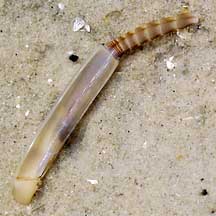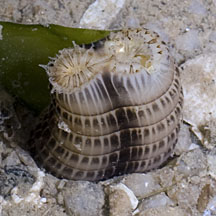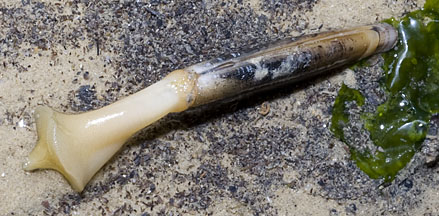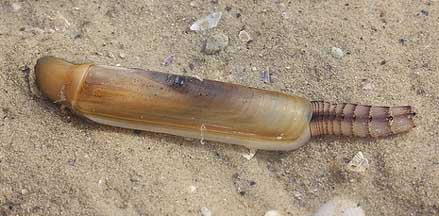Razor
clams
Family Solenidae
updated
May 2020
if you
learn only 3 things about them ...
 On one end is the long siphon, and the other a strong
muscular foot. On one end is the long siphon, and the other a strong
muscular foot.
 The
thin flexible shell allows it to slip easily into the
sand. The
thin flexible shell allows it to slip easily into the
sand.
 They are rapid burrowers. Let's put this one down and
see how fast it can burrow. They are rapid burrowers. Let's put this one down and
see how fast it can burrow. |
|
Where
seen? These almost cylindrical clams can move surprisingly
quickly and are rarely seen as they are usually buried in the sand.
They are sometimes seen above ground on the undisturbed sandy shores
near seagrass areas on our northern shores. They are adapted for burrowing
deeply in soft bottoms. |

Razor clam (Solen
brevisiima)
Foot burrowing in (left) and siphon extended (right).
Chek Jawa, Jan 04 |

Siphon of a large buried razor clam
Changi, Jul 11 |
|
| Built for digging: 1.5-5cm long.
The razor clam is a strong and quick burrower. The somewhat rectangular
and cylindrical two-part shell is thin, narrow and smooth, allowing
the animal to slip easily through the sand. On one end of the shell
emerges a strong foot that it uses to burrow quickly into wet sand.
On the other end a long siphon sticks out to the surface to breathe
and feed. The siphon breaks easily when the animal is disturbed. In
this way, the animal probably avoids being dragged out of the sand
by its siphon. |

Bulbous tip of the muscular foot.
Pasir Ris, Dec 11 |
|
What do they eat? Like other bivalves,
razor clams are filter feeders. The buried clam sticks its long siphon
out to the surface. When submerged, it sucks in a current of water
through the siphon. It uses its enlarged gills to sieve food particles
out of this current.
Human
uses: Larger razor shells are edible and are collected
as food. Like other filter-feeding clams, however, razor clams
may be affected by red
tide and other harmful algal blooms. Such clams can then
be harmful to eat. |
*Species are difficult
to positively identify without close examination.
On this website, they are grouped by external features for convenience of
display.
| Razor
clams on Singapore shores |
| Other sightings on Singapore shores |

Pasir Ris Park, Dec 09
Photo
shared by James Koh on his blog. |
|
Family
Solenidae recorded for Singapore
from
Tan Siong Kiat and Henrietta P. M. Woo, 2010 Preliminary Checklist
of The Molluscs of Singapore.
| |
Solen
brevissimus
Solen delesserti
Solen linearis
Solen pseudolinearis
Solen vagina |
|
| Links
References
- Tan Siong
Kiat and Henrietta P. M. Woo, 2010 Preliminary
Checklist of The Molluscs of Singapore (pdf), Raffles
Museum of Biodiversity Research, National University of Singapore.
|
|
|




